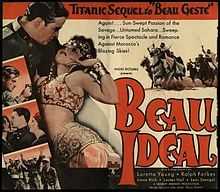Beau Ideal
| Beau Ideal | |
|---|---|
 | |
| Directed by | Herbert Brenon |
| Produced by | William LeBaron (producer) |
| Written by |
P C Wren (novel Beau Geste) Paul Schofield (adaptation and dialogue) and Elizabeth Meehan (adaptation and dialogue) |
| Starring | See below |
| Music by | Max Steiner |
| Cinematography | J. Roy Hunt |
| Editing by | Marie Halvey |
| Studio | RKO Radio Pictures |
| Distributed by | RKO Radio Pictures |
| Release dates | January 19, 1931 |
| Running time |
82 minutes 79 minutes (Canada, Ontario) |
| Country | USA |
| Language | English |
| Budget | $707,000[1] |
| Box office | $575,000[1] |
Beau Ideal is a 1931 American film directed by Herbert Brenon and released by RKO Radio Pictures. The film was loosely inspired by the adventure novel, Beau Ideal, by P C Wren the third novel in a trilogy (up to then) after Beau Geste and Beau Sabreur. (Eventually the writer would also publish Good Gestes and Spanish Maine, making in all five books around the same characters).
In 1958, the film entered the public domain in the USA due to the copyright claimant's failure to renew the copyright registration in the 28th year after publication (the film is copyright 1930).[2]
Plot summary
The hero, John Geste, joins the French Foreign Legion to find a childhood friend, Lester Veil, whom he discovers imprisoned in a desert grain silo with other disgraced Legionaires. Following a flashback to their boyhood in England, they make their escape. After many adventures, Geste finally helps Vail to avoid keeping his extorted promise to marry the Emir's favourite dancer, who is known as "the Angel of Death". They return to England where Vail's platonic love and ideal of woman Isobel Brandon (bethroted to John Geste) is waiting.[3]
.jpg)
Cast
- Ralph Forbes as John Geste
- Loretta Young as Isobel Brandon
- Irene Rich as Lady Brandon
- Lester Vail as Otis Madison
- Frank McCormick as Carl Neyer
- Otto Matieson as Jacob Levine
- Don Alvarado as Ramon Gonzales
- Bernard Siegel as Ivan Radinoff
- Myrtle Stedman as Mrs. Frank Madison
- John St. Polis as Judge Advocate
- Joe De Stefani as Prosecuting Attorney
- Paul McAllister as Sergeant Frederic
- Hale Hamilton as Major Laboudy
- George Regas as The Emir
- Leni Stengel as Zuleika - the "Angel of Death"
Reception
The film recorded a loss of $330,000.[1]
See also
References
- ↑ 1.0 1.1 1.2 Richard Jewel, 'RKO Film Grosses: 1931-1951', Historical Journal of Film Radio and Television, Vol 14 No 1, 1994 p58
- ↑ Pierce, David (June 2007). "Forgotten Faces: Why Some of Our Cinema Heritage Is Part of the Public Domain". Film History: An International Journal 19 (2): 125–43. doi:10.2979/FIL.2007.19.2.125. ISSN 0892-2160. JSTOR 25165419. OCLC 15122313. See Note #60, pg. 143
- ↑ New York Times: Movie review published January 19 1931.
External links
- Beau Ideal at the Internet Movie Database
- Beau Ideal is available for free download at the Internet Archive [more]
| |||||||||||||||||||||||||||